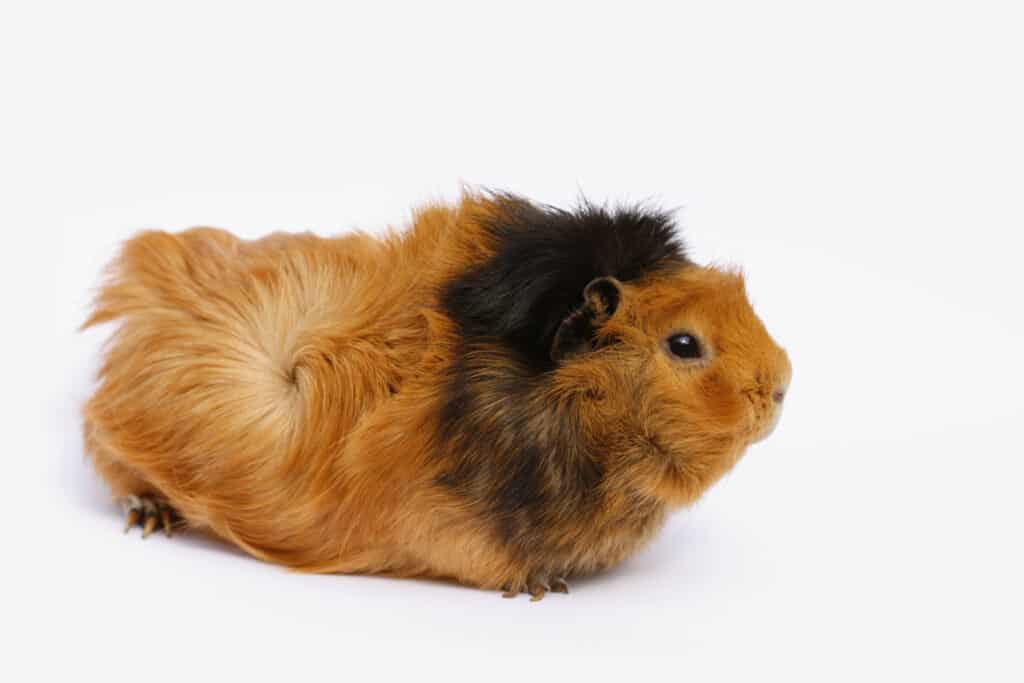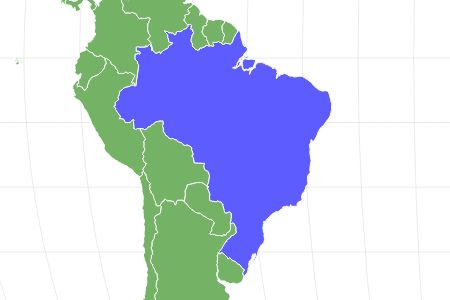Abyssinian Guinea Pig
Cavia porcellus
They are one of the oldest breeds of guinea pig
Advertisement
Abyssinian Guinea Pig Scientific Classification
- Kingdom
- Animalia
- Phylum
- Chordata
- Class
- Mammalia
- Order
- Rodentia
- Family
- Caviidae
- Genus
- Cavia
- Scientific Name
- Cavia porcellus
Read our Complete Guide to Classification of Animals.
Abyssinian Guinea Pig Conservation Status
Abyssinian Guinea Pig Facts
- Name Of Young
- Pups
- Group Behavior
- Herd
- Fun Fact
- They are one of the oldest breeds of guinea pig
- Most Distinctive Feature
- Rosette patterned fur
- Gestation Period
- 58-72 days
- Temperament
- Social
- Age Of Independence
- 21 days
- Litter Size
- 5-15
Abyssinian Guinea Pig Physical Characteristics
- Color
- Brown
- Black
- White
- Brindle
- Skin Type
- Fur
- Top Speed
- 4 mph
- Lifespan
- 5-15
- Age of Sexual Maturity
- 3 months
- Age of Weaning
- 21 days
View all of the Abyssinian Guinea Pig images!
“Abyssinian guinea pigs are one of the oldest breeds of guinea pigs, residing in the mountains of South America.”
Summary
Despite the name, guinea pigs are not pigs at all but a type of rodent. They are known for their uniquely rough, rosette-patterned fur and ability to make loud noises. These animals make spectacular house pets and are very friendly. In fact, they have been popular house pets since the 1600s. They have a much more social personality than other guinea pig breeds, which is partly what makes them so popular.
5 Incredible Abyssinian Guinea Pig Facts
- They come in a plethora of colors – from monotone to colorful. Their solid colors come in many shades and styles, such as roan, tortoiseshell, Himalayan, Dutch, Dalmation, and many others.
- While guinea pigs are a common pet all across the globe, in South America they are also a prevalent food source, and you can still find street stalls selling roasted guinea pigs.
- They are much more social and energetic than other guinea pigs.
- They have four toes on each front foot and three on each back foot.
- Despite their name, they did not originate in Abyssinia (modern-day Ethiopia).
Abyssinian Guinea Pig Scientific Name
Scientifically known as Cavia porcellus, the Abyssinian is one of the oldest guinea pig breeds. Despite the name, the rodent did not originate in Abyssinia, now known as Ethiopia. While the actual origin of their name is largely unknown, like other breeds of guinea pigs, they inhabit mountainous areas in South America. This breed, like most others, is domesticated all across the globe. They are descendants of a rodent called Cavia cutleri, and their domestication likely first began around 5000 BCE.
Abyssinian Guinea Pig Appearance
The Abyssinian guinea pig is a small rodent, about 8-12 inches in length, and it weighs about two to three pounds. For comparison, they are about the same size as an adult male’s shoe.
Abyssian guinea pigs look quite similar to other breeds of guinea pigs. They have long bodies, broad heads, and short faces. Their ears droop downwards and are shaped like petals. Some also have a lush bush of hair under their noses.
A unique feature of the Abyssinian guinea pig is its rough, “rosette” patterned fur. Unlike other breeds, the Abyssinian doesn’t have any flat or smooth spots. Instead, their fur usually has eight to 10 rosettes each, which are in pairs. They extend all over their bodies, from head to toe. While rough, the fur grows circularly and could be as long as 2 inches.
They come in a few different colors but primarily neutral shades. Their most popular colors are white, black, brown, brindle, roans, tortoiseshell, and red.

Abyssinian guinea pigs have long bodies, broad heads, and short faces. They can be a variety of colors, including red.
©iStock.com/svehlik
Behavior
In the wild, the Abyssinian guinea pig lives in groups called herds. These social animals are quite vocal and do not shy away often. The unique noise these rodents make is a high-pitched squeal or whistle.
Although many live in the wild, they have been domesticated, so they’ve become quite accustomed to the indoors. They can live alone but prefer to be with more of their kind because they are social creatures. It’s recommended that you keep at least two of them if you’re considering having them as pets.
Habitat
Abyssinian guinea pigs are only found in South America in the wild, either in forest-covered areas, open grasslands, or in the mountainous regions of the Andes. They can survive in elevations of up to 16,000 feet above sea level! The Abyssinian guinea pig has a vast range and can be found from Venezuela to southern Patagonia, but they are not found in western Chile or most of the Amazon River basin.
Abyssinian Guinea Pig Diet
They are herbivores that feed on bushes, fresh vegetables, fruits, grass, and seeds.
What does the Abyssinian guinea pig eat?
The diet of Abyssinian guinea pigs is plant based – making them herbivores. Out in the wild, their diet is largely based on grass, leaves, seeds, bark, and flowers on the mountain slopes of South America. In captivity, they can eat manufactured nutrition pellets, hay, and various fruits and vegetables.
Overall, their diet resembles that of most other guinea pig breeds. Timothy hay, a grassy form of hay that is important for their diets, is often fed in captivity. They also need vegetables in their diet for them to fulfill their vitamin and mineral requirements. Usually, green, leafy vegetables are sufficient. Additionally, adding fruits to their diet can boost their digestive system and vitamin C intake.
What eats Abyssinian guinea pigs?
Their main predators are mammals such as weasels and birds of prey like eagles and hawks. In a home environment, they might be susceptible to attacks from domesticated cats or dogs. In South America, guinea pigs are a common food source.
Predators and Threats
As mentioned above, these guinea pigs are susceptible to being preyed on by larger animals, particularly mammals and predatory birds. Nevertheless, they’ve developed natural instincts to help them survive. They usually escape by hiding in burrows, where larger animals cannot enter. Although deforestation negatively affects some guinea pigs, these animals adapt well to change, so human factors and climate change do not affect the population much.
Abyssinian Guinea Pig Reproduction
The Abyssinian guinea pig usually reaches sexual maturity at three months old. Out in the wild, these animals have no specific breeding season and can breed at any time of the year. However, having babies in the winter is often rare. Their gestation period is between 58 to 72 days, and a female gives birth to between five and 15 pups at one time. Over the year, a female might give birth to up to five litters.
Abyssinian Guinea Pig Babies
The babies are known as pups. They are usually very well-developed when they’re born and have long hair – a feature unique to them. They usually suckle on their mother’s milk for up to 21 days, after which they can graze independently. A single litter of pups can range from five up to 15!
Lifespan
The average lifespan of an Abyssinian guinea pig is anywhere between five and eight years. And the longest-living Abyssinian guinea pig on record reached 15 years in captivity.
In terms of diseases, they are susceptible to some common ailments. A few are as follows:
- Pneumonia – caused by bacterial infections
- Diarrhea – gastrointestinal issues
- Scurvy – a deficiency of vitamin C
- Urinary problems – bladder stones, blood in urine, etc.
Therefore, if you keep one as a pet, you should schedule regular vet visits and provide a well-balanced diet.
Population
The overall population of the Abyssinian guinea pig is currently unknown. There might be a chance of their population declining, considering modern-day urbanization and deforestation. Nevertheless, information about these trends is based on speculation.
Abyssinian Guinea Pigs as Pets
Abyssinian guinea pigs make great pets. They are docile, social, and loving animals that are relatively easy to take care of. A staggering 1.5 million households in the United States alone own guinea pigs. So it goes without saying that these are popular pets.
Abyssinian Guinea Pigs in Zoos
Abyssinian guinea pigs are commonly found in zoos around the world. You can visit them in some of the following zoos in the USA:
Related Animals
View all 194 animals that start with AAbyssinian Guinea Pig FAQs (Frequently Asked Questions)
Are Abyssinian guinea pigs carnivores, herbivores, or omnivores?
Abyssinian guinea pigs are herbivores.
Are Abyssinian guinea pigs rare?
They’re very common. In fact, they’re the oldest breed of guinea pigs and can easily be found at pet stores and in the wild.
Do Abyssinian guinea pigs bite?
They might gently nip sometimes. However, they don’t usually bite and are very docile and friendly.
Is it easy to bond with Abyssinian guinea pigs as a pet?
Absolutely! They’re quite friendly and easily warm up to humans.
How much does it cost to buy an Abyssinian guinea pig?
Abyssinian guinea pigs cost between $15 and $100 on average.
Thank you for reading! Have some feedback for us? Contact the AZ Animals editorial team.
Sources
- Pet Keen / Accessed November 8, 2022
- San Diego Zoo / Accessed November 8, 2022
- Home and Roost / Accessed November 8, 2022


















